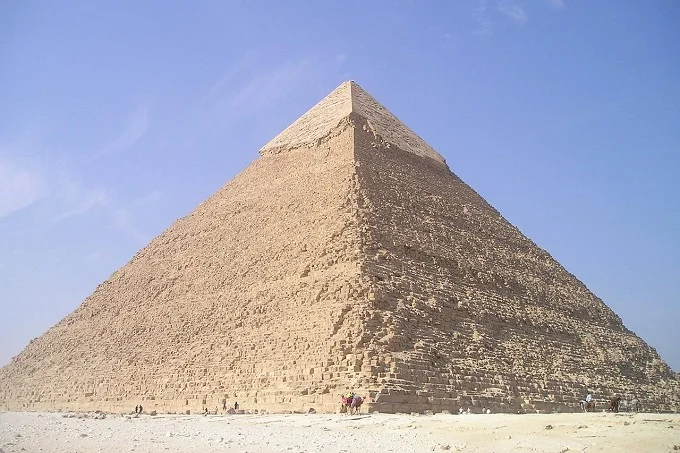How they moved stones with sound

Occultists have long said that even the Atlanteans and ancient Egyptians when building their sanctuaries, were able to move their massive stone parts by means of sound, that is, they possessed acoustic levitation.
Seriously, science is extremely skeptical about this, preferring historical reconstructions that depict tens of thousands of slaves involved in the construction, and ropes with blocks. How were huge blocks similar to this stone from the Baalbek complex moved?
Flying Rocks
In the early 1930s, Swedish aeronautical engineer Henri Kjellson watched monks in Tibet build a temple on a rock 400 meters high. About a meter and a half in diameter, a yak dragged the stone to a small horizontal platform 100 meters away from the cliff. Then the stone was dumped into a pit corresponding to the size of the stone and 15 centimeters deep.
Nineteen musicians stood 63 meters from the pit (the engineer measured all the distances accurately), and behind them stood 200 monks, arranged in radial lines, several people on each line. The angle between the lines was five degrees. The stone lay in the center of this formation.
The musicians had 13 big drums suspended on wooden crossbeams, with their sounding surface facing the pit with the stone. Six big metal pipes were placed between the drums in different places, also directed by the nozzles to the pit.
To get the latest stories, install our app here.
Beside each pipe stood two musicians, blowing into it in turn. The whole orchestra would play loudly at a special command, and a chorus of monks would sing in unison. Four minutes later, as Henry Kjellson tells it, when the sound was at its highest point, the boulder in the pit would rock up and down and, parabolic, would fly straight to the top of the cliff!

In this way, according to Henry’s story, the monks would carry five or six huge boulders to the temple under construction every hour!
What was the trick?
As an engineer and an aeronautical one at that, Kjellson tried to explain the incredible phenomenon in terms of common sense. Henry was well aware that every little detail counted in the study of something out of the ordinary. Those involved in aviation know that the “little things” often pay for the lives of pilots and passengers.
Kjellson measured all the distances – from the pit to the rock, from the pit to the standing musicians and monks and so on and got figures, all multiples of the number “PI”, as well as the golden ratio and the number 5.024 – the product of “PI” and the golden ratio.
The stone was in the center of the circle formed by the orchestra and the monks, who sent sound vibrations to the pit, a reflector of these vibrations. That’s what lifted the boulder 400 meters! The sounds rose smoothly (four minutes, or 240 seconds), were beautiful enough, and the vibrations were harmonious. The result was such a creative effect. It was a creative effect because a sacred temple was being built!
The stone took off along a parabola – at first, it went almost vertically (vibrations, reflecting off the rock, did not allow the boulder to approach it), then it began to deviate toward the top. Closer to the rock stood a smaller number of monks on the lines-radiuses, hence, vibrations and their reflections were weaker, and to the top, their number at all began to fall sharply, and the stone, following the path of least resistance, exactly got to the place of erection of the sanctuary!
It is likely that in the same way, the ancient builders of the pyramids and other global structures moved unbearable boulders for considerable distances and great heights.
To get the latest stories, install our app here.
A triumphant experiment
Physicists, in general, allowed the possibility of the existence of controlled acoustic levitation. Not only that, they mastered the technology to control it first in one and then in two planes.
Probably, many people had a chance to see macrofilming with a water droplet hovering in the air. Such experiments were performed, for example, by scientists from Switzerland. But nobody managed to achieve three-plane control of the process for a long time.
And specialists from the University of Tokyo Yoichi Ochiei, Takayuki Hoshi and Yun Rekimoto made small objects of different shapes and weights float in space with the help of sound waves. Japanese matrices of directional sound emitters, located at specific points, allow them to move along complex trajectories.
At first, scientists operated with already familiar water droplets, pieces of polystyrene 0.6 to 2 millimeters in diameter, and small radio elements, but the crowning moment of the series of experiments was when a child’s constructor cube was placed on top of a toy pyramid.
Realities and prospects
Japanese experts say that their system of manipulating objects in space has two original features. The force acting on an object is the result of the addition of several directed beams of ultrasonic waves. This produces a standing sound wave and captures its minima and maxima at strictly defined points in space. Using one or more directional emitters, the Japanese change the parameters of this standing sound wave, forcing it to move in space on the trajectory they need, which leads to the movement of the object held by the wave.
Specifically, the experiments used four speakers that emit sound waves of over 20 kilohertz, which are inaudible to the human ear and come from four directions, intersecting each other in a limited space. Using the sound of varying power, they are able to move objects of different shapes, made of materials with different densities, while controlling their position in space with millimeter accuracy.
Experimenters assure that after some time, they will be able to manipulate objects of any mass and volume in the same way. All that is left is to learn how to select a sound of a certain frequency and power. They also say that acoustic levitation will help in the future to fully overcome the Earth’s gravity. NASA engineers are already interested in using this technology to create a new type of aircraft.
As for its use in construction in ancient times, the authors described it in different ways. The medieval Arab scholar al-Masudi wrote that first, they put a “magic papyrus” under the stone, then hit it with a metal rod. This allowed the stone to detach from the ground and float along a stone-paved path bounded by metal staves. The megalith moved along the path for about 50 meters, and then lowered to the ground. The process was repeated each time until the stone was placed in the right place.
Nowadays, presumably, no one will bang sticks and blow copper pipes. Most likely, the Japanese will make something quite high-tech. Of course, if everything goes according to plan.
To get the latest stories, install our app here.




